Epic art of Gorogly
Inscribed in 2015 (10.COM) on the Representative List of the Intangible Cultural Heritage of Humanity
The epic art of Gorogly is an oral performing tradition describing the achievements of the legendary hero Gorogly and his forty cavalrymen. The epic incorporates narration, singing, composition, prose, poetry and vocal improvisation, and also functions as an oral encyclopaedia of traditional customs and knowledge (including stock breeding, traditional healing, etc.). Its transmission plays an important role in the upbringing of children by helping them to better understand their cultural identity. The tradition nurtures character, creative capacity and artistic skills, and provides bearer communities with a strong sense of social and cultural identity. The epic reflects the aspirations of the Turkmen people for a happy life, freedom and justice, and promotes values such as bravery, honesty, friendship, tolerance and fairness. Its bearers and practitioners are individual male and female epic performers in Turkmenistan who specialize in the Gorogly epic. The epic is traditionally performed seated to the accompaniment of stringed musical instruments, such as the dutar or gyjak. Bearers and practitioners of the Gorogly epic art take an active part in all national celebrations, cultural festivals and social gatherings, as well as annual competitions between Gorogly epic performers. Practice of the epic art is considered a vocation with masters combining informal teaching of pupils with transmission of knowledge and skills during public performances.










